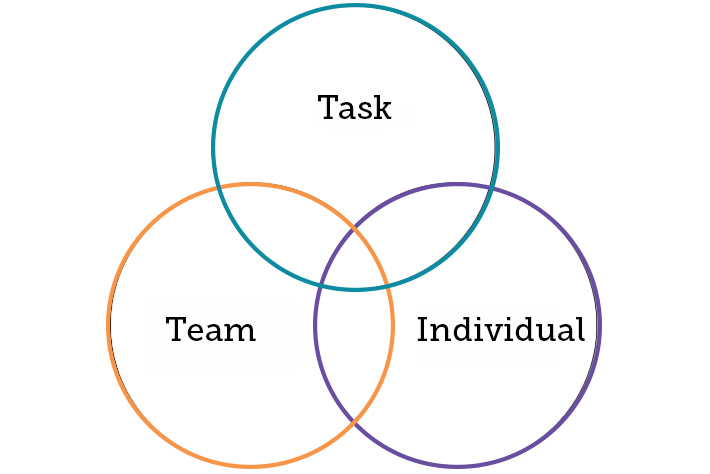John Adair’s Action-Centred Leadership is a classic leadership model, first shared in 1973[i]. It’s used widely in management development to help managers get to grips with the multiple responsibilities that they need. A lot has changed over the last fifty years, and the situations we face as managers feel increasingly complex. Is this model still relevant?
Adair was one of the first to say that leadership is what you do (the actions you take) rather than a trait or personality quirk. Therefore, anyone, in any role, can learn how to be a great leader.
For managers, this is particularly important: managers are often promoted because they are excellent at the core purpose of their role – the tasks that they do. By being an expert, it follows that managers can and should help to develop others to be the same. However, Adair noted that being a great manager means more than being a task expert: you also have to be a people expert. In fact, you don’t even need to be an expert of all the tasks that your team need to excel at; they can be their own experts. For you to succeed as a great manager, you need to develop your leadership skills.
To illustrate the key areas needed to lead your team effectively, the model uses three overlapping circles as per the diagram below:

As a manager, we need to have a command of all three areas as they are mutually dependent – take away one element and it will have an impact on the other two areas.
Let’s have a look at each area in turn.
This is all about identifying the tasks that need to be done, outlining priorities and ensuring that they can be achieved. It involves creating plans and budgets, allocating resources and monitoring and reviewing: ‘did we achieve what we set out to achieve?’
Whilst the tasks we are doing may have evolved over the last fifty years, it’s still just as important that we are able to deliver what we set out to do. Working in mission-driven organisations, the tasks we’re setting out to achieve need to have an impact in the wider world. As managers, we need to help our teams connect the mounting to-do lists to the wider change we’re seeking to make. Tasks are strategic. Even if the ways in which we work have evolved a great deal.
This means, as well as considering what we’re doing, we need to think about how we are achieving our goals. We need to consider what the potential unintended consequences of our work could be and ensure that we stop those from happening. For example, the work that is happening in some charities about power inequality, and how to empower the global majority and marginalised groups of people. If we are to change the way we deliver our missions, we need innovation and creativity. This will require a new way of imagining our work, and so we need diverse thinking. Therefore we need to consider our Team.
It’s a key part of a manager’s role to build an inclusive team who work effectively together. This might mean considering how the team communicates with each other, works together with other teams and resolves conflict if it arises.
Technology has changed the way we communicate and share information, and this has particularly accelerated over the last few years. Working in a hybrid way, with more people working from home or from different bases, can mean people experience more disconnect and isolation. And yet, very few people can deliver their work or reach their goals entirely on their own. Therefore, it’s crucial for managers to find creative ways to bring people together. We need to foster connection both within teams and with colleagues across the organisation. This creates a sense of belonging and inclusion for each individual within the team. One that is so much more than a ‘nice to have’ feature of team culture.

A team that feels connected and safe is one where people share information readily. They are not protective over their own ideas or success. They can hold honest conversations and point out when things are not going well. They can innovate without fear of blame or ridicule if experiments don’t work out. However, this doesn’t mean that the manager needs to treat everyone in the team in exactly the same way. Instead, we need to consider the Individual.
Each person is unique and therefore we need to understand what it is that person needs for them to be at their best and deliver in their role. This involves building a relationship with that person, so that you can find out what they are looking for from work. You can then explore what might help them achieve that. This is still as relevant as it always was – without great people, we aren’t able to deliver.
For people to be great at their work, they need tools, resources, time, knowledge, skills and abilities. They might also need help overcoming barriers that may be getting in their way. As a manager, our role is to provide these, and to develop them over time.
Adair’s three responsibilities concept helps us to understand that what makes a manager a great manager is not about authority, hierarchy, power or a job title. Instead, it’s the fact that you are now responsible for yourself, as well as for the success of others too.
Authority in this sense is not a right, but a responsibility: your authority as a manager makes you responsible for making the right decisions, making the best of your resources, and ensuring the people who work with you have everything they need to deliver great work. That’s a lot for one person to consider, particularly as charities face demands to do even more with shrinking budgets and resources.
If you find yourself thinking “this all sounds great, but I can’t look in three directions at the same time, never mind do it and fit in my other duties,” you’re right. It’s not about focussing on all three of these areas all of the time. Instead, we can use Adair’s concept as a checklist to help us think about what’s needed right now and ensuring that over time, we’ve got the right balance between team, task and individual.  For example:
For example:
And that’s why this model is so useful and very much still relevant today. It’s a simple reminder for us to lift our heads up and look across the whole picture and adjust to what’s happening.
The context may be different and our ways of working will never be the same as they were in the 1970s but having oversight over the task, the team and the individual remain key to being a great manager.
If you want to spend time thinking about what this would look like for you and your management development, contact us or call 020 7978 1516 to speak to one of our Learning & Development consultants.
[i] Adair, John Effective Leadership (Pan) 2009 This book explains his three-ring model of leadership roles.